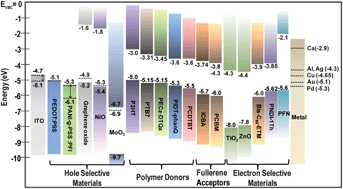This article provides an overview on the recent development of solution processed organic, inorganic, and hybrid interfacial materials for bulk-heterojunction polymer solar cells. The introduction of proper interfacial materials to optimize the electronic and electrical properties between the interfaces of the light-harvesting active layer and the charge-collecting electrode has become an important criterion to improve the performance of polymer solar cells. The electronic processes at these interfaces play a critical role in determining the efficiency for photon-to-electricity conversion. An ideal interface requires the formation of Ohmic contact with minimum resistance and high charge selectivity to prevent charge carriers from reaching the opposite electrodes. For long-term stability of polymer solar cells, interfaces with matched surface energy are required to prevent interfacial dewetting and delamination. Several classes of interfacial materials including inorganic metal oxides, crosslinkable charge-transporting materials, conjugated polymer electrolytes, self-assembled functional molecules, and graphene-based materials are highlighted and the integration of these interfacial materials with new low bandgap polymers and fullerene derivatives as active materials in different device architectures is also discussed.

You have access to this article
 Please wait while we load your content...
Something went wrong. Try again?
Please wait while we load your content...
Something went wrong. Try again?


 Please wait while we load your content...
Please wait while we load your content...